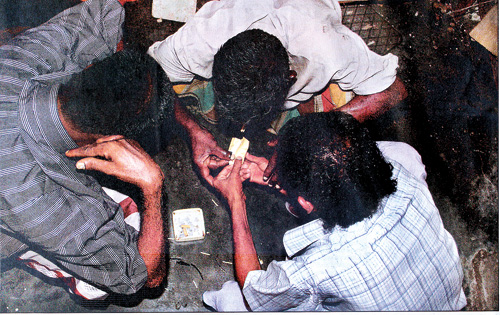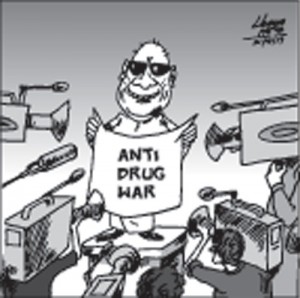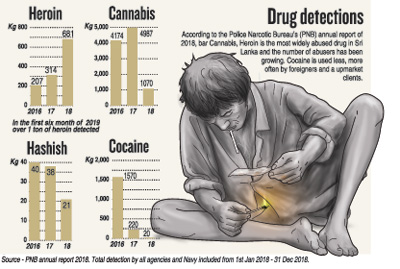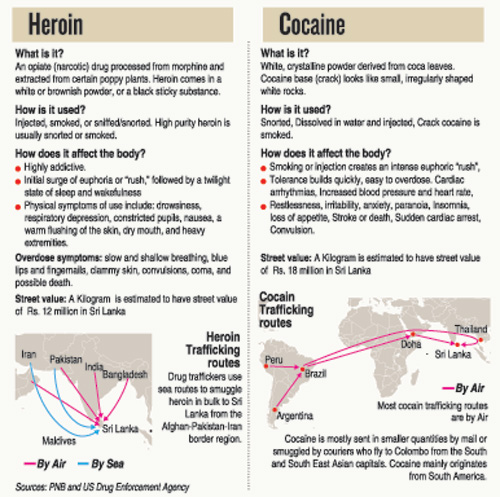News
Narcotics mystery: Where do all the detected drugs go?
 President Maithripala Sirisena launched an ambitious anti-narcotic drive and vowed to hang convicted drug lords. Only a Supreme Court directive till October 30 is keeping him away.
President Maithripala Sirisena launched an ambitious anti-narcotic drive and vowed to hang convicted drug lords. Only a Supreme Court directive till October 30 is keeping him away.

A recent detection of heroin
His declared objective, repeated publicly, is to curb drug use and thus deal a death blow to that trade. However, an investigation by the Sunday Times this week revealed a more damning concerns about this exercise. Where does all the detection of drugs go? Are they ending up in the market again through the same drug kingpins he is trying to oust from the trade? Is this creating more drug addicts than reducing them?
The Sunday Times has not been able to discern where all the major hauls of heroin end up due to the lack of transparency on what happens to the drugs taken into custody. Last year alone, more than 700 kilogrammes of heroin were detected. In the previous two years, more than 500 kilos of heroin were detected by the Police Narcotics Bureau.
During much publicised ceremonies on two different occasions, a stock of only 1.5 tons of cocaine was destroyed. They went up in smoke as President Sirisena watched.
No one holding official positions was able to explain why there is a long delay in the disposal of the heroin.
The Sunday Times learns that, of the large stocks detected, only a small quantity is required to be sent to the Government Analyst for examination before those arrested with the drugs are prosecuted.
“The Government has been questioned about the matter and there is a need for transparency,” said Alcohol & Drug Information Centre (ADIC) Executive Director Pubudu Sumanasekara.
He said there had been a lack of consultation with civil society and other stakeholders over the issue.
This was confirmed by Kalinga Indatissa, PC, President of the Bar Association of Sri Lanka (BASL).

Pic by Nilan Maligaspe
“There has been no consultation with us, if the government reaches out, we can help it with the process” he said.
The lack of transparency in what happens to the narcotics taken into custody and the delays in the destruction of narcotics evidence caused the public and civil society activists to question the process involved. Some have expressed suspicion that the drugs taken into custody end up back on the streets.
Earlier this year, the Presidential task force on prevention of drugs had worked closely with the Government Analyst’s Department to reduce the time taken by the apex forensics body to submit reports to court on the type, purity and weight of suspected narcotics taken into custody.
The delays in submission of the forensics report had been identified as one key factor that plagues the process. The goal is to reduce the time taken to prepare and submit the report in three months, whereas, at present, it takes almost a year at times.
The Government Analyst’s Department is to deal with a large backlog of casework and is understaffed, a senior officer, who did not wish to be named, told the Sunday Times.
“In the coming months, we are planning to recruit more than two dozen scientists to bolster the ranks and we have asked for assistance for capacity building in the laboratories,” he explained.
The destruction of 769kg of cocaine in April had come after a lengthy legal process. The current procedure is that the narcotics taken into custody is held as evidence until the case moves up to higher courts, a conviction is made and the appeal process is exhausted.

DIG Medawatte
According to Deputy Inspector General Sajeewa Medawatte, the Police Narcotics Bureau (PNB) chief, in recent years, the number of heroin detections had increased.
The figure stood at 46kg in 2015, but showed an increase over the past three years – 206kg in 2016, 314kg in 2017 and 739kg in 2018.
This year, so far, the PNB has detected nearly 800kg of heroin while other agencies have detected about 400kg of heroin.
Explaining the process from detection to prosecution, DIG Medawatte said if the amount is more than two grams, it should be sent to the Government Analyst’s Department by the PNB or any other agency that makes the detection.
Whatever the PNB detects is sent to the Government Analyst’s Department and stored there. The PNB does not retain the drugs taken into custody, the DIG said, adding that it was the Government Analyst’s Department which determines the weight and purity of the narcotic substance.
He pointed out there were disparities in the PNB and the Government Analyst’s reports with regard to the weight of heroin taken into custody.
This is because the Government Analyst’s report gives only the weight of the pure heroin.
The PNB chief said a court case after detection could take about five years or even longer if it went up to the appeal process.
Asked about detections involving quantities less than two grams, DIG Medawatte said there was provision in the Poisons, Opium, and Dangerous Drugs Act to cite the Government Analyst’s report as evidence and obtain a magistrate’s court order for the destruction of the drugs.
“But even that provision is not made use of because of fears that the destruction of the drugs may have an impact on the final verdict of the case,” DIG Medawatte explained.
DIG Medawatte said it also took time to obtain the Government Analyst’s reports because the department, in addition to reports on drugs, was burdened with the task of submitting forensic reports related to weapons, explosives, murders, rapes and other crimes.
He said destroying heroin and cocaine was a difficult process, as it could be done only at temperatures above 2000 centigrade and such facility was available only in a cement factory.
Answering our query as to why a large stock of cocaine was destroyed and not the stocks of heroin detected in raids, the DIG said the cocaine stocks had no suspects and therefore the process was quick.
The Sunday Times learns that as a result of these legal requirements and processes, a large stocks of narcotics have been retained in evidence lockers for years.
Police sources told the Sunday Times that smaller quantities taken in to custody from drug users and small scale distributors were destroyed under the supervision of magistrates and police officers and this took place in district court premises.
Apparently, this procedure has long been followed and it is not open to public viewing.
To bring in more transparency and expedited the destruction process, an amendment to the Poisons, Opium, and Dangerous Drugs Act has been drafted by the Legal Draftsman’s Department and is awaiting the Attorney General’s approval, the Sunday Times has learnt.
The amendment comes in the backdrop of growing calls from law enforcement agencies and other government stakeholders, who believe the current laws governing narcotics are outdated.
According to the amendment, narcotics held as evidence in ongoing court cases can be released for destruction. If introduced it will allow magistrates to direct court officials to take a sample of drugs taken into custody as evidence and release the bulk to be destroyed.
Thus, the Government Analyst’s report and the sample will be used as evidence in the continuation of the trial, instead of retaining the entire stock till the trial ends.
The changes to the laws were first mooted by the Ministry of Justice.
The Police Narcotics Bureau (PNB) and the National Dangerous Drugs Control Board (NDDCB) will hold further talks with the Attorney General’s department on the draft amendment.
Once approved, the amendment will be presented in Parliament.


